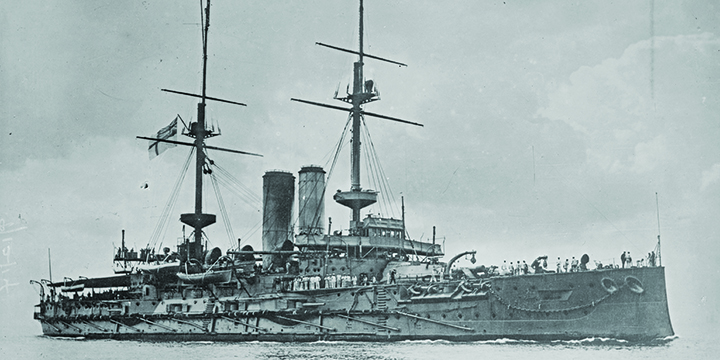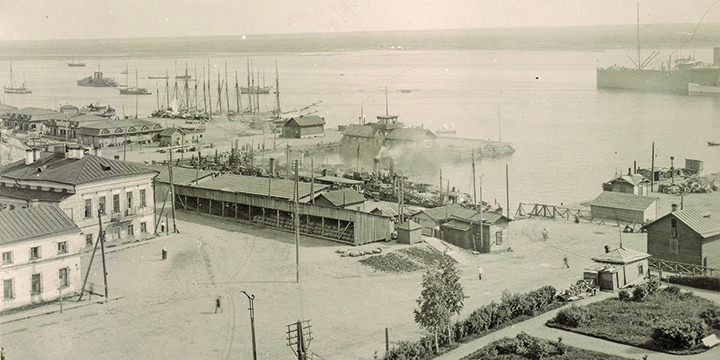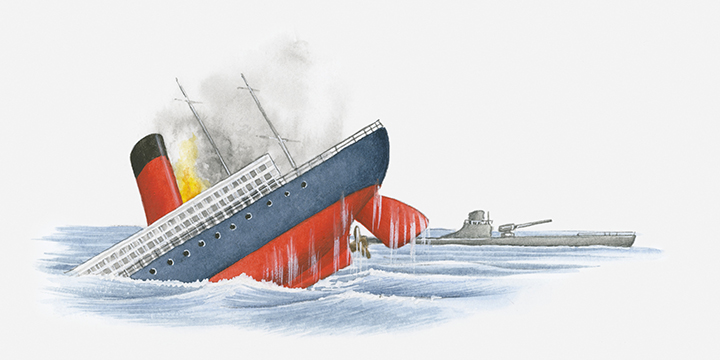
In October 1917, the British cargo steamer Baron Balfour was torpedoed by a German submarine off the Russian coast. Charles Scott was an engineer onboard the vessel and wrote an account of the voyage. His grandson, John Peterson, hopes the article might raise awareness of the risks that merchant seafarers faced then, and continue to face now, and encourage some contributions to the charities that work on their behalf
For three years in the 1914-1918 war I was a sea-going marine engineer, writes Charles Scott. The last ship I served on was the Royal Naval Transport Baron Balfour. At this time it berthed in a Liverpool dock, being fitted out with special fixtures in order to carry, with reasonable safety, a large quantity of 4-7 inch high-explosive TNT shells, ordinary shells (various), cylinders of poisonous gas, vehicles, guns and many other instruments of war.
We sailed under sealed orders for 24 hours which, when the seal was broken, indicated that we head for Lerwick in the Shetland Islands. For five days we lay at anchor, somewhat isolated in Lerwick’s fairly extensive waters, and then we were instructed to sail for Tromso in northern Norway. We had a short stay of about three days in the waters adjacent to Tromso, and then we were instructed to proceed to Murmansk.
From Liverpool to Murmansk is about 2,100 miles, but so far we had not tied up to any quay or unloaded any of the deadly cargo, which was supposedly worth about £1m. Our movements always appeared to be very secretive – which, in consideration of the cargo we were carrying, is understandable and probably the main reason we were anchored in an isolated location.

Image: Naval History and Heritage Command
We had been anchored in Murmansk for five days when news came through that we had to proceed to the Russian port of Archangel located off the White Sea on the Dvina river. So far this voyage generally appeared to have been quite normal and probably not unusual in time of war. But from then on terrible and most alarming incidents began to happen.
We left Murmansk early morning. The atmospheric conditions were bad with drifting fog or mist hanging in the air. It is not easy to judge distances accurately in such weather and suddenly a ship showed up, like a ghost out of the fog, on our starboard side. It was travelling somewhat faster than us but on a collision course and unfortunately too close to do much about it.
In a few seconds we collided, our bow striking and going deep into the other ship on the port side just aft of the hawse pipe. Unfortunately, three men on the forecastle of the damaged ship were killed. No serious damage was suffered by us and after some delay we passed through the control ‘gate’ and out into the North Sea on an easterly course before turning south into the waters of the White Sea.
We had now travelled about 350 miles from Murmansk and the atmospheric conditions were giving us a lot of concern. With nasty drifting fog our visibility was quickly getting uncertain at a safe distance. Suddenly, a solid vertical cliff of rock showed up ahead. The navigational officer on the bridge called to the helmsman 'full over to starboard' and the engine telegraph rang demanding an immediate stop. The ship, travelling at a fair speed, turned to starboard smartly and the engine telegraph then rang urgently 'full astern'. The weight of the ship carried her forward with sufficient power to force her over a low water rocky area and drive her crunching and grinding on to the edge of a low-lying rocky beach.
Unfortunately, the rocks had punctured and torn into the bow and bottom plates. In many places these had ruptured right through to the forward tank top. The screeching and noise of this ship as this disaster took hold and sharp rocks continued to bite, is indescribable. It was fortunate that the sea was reasonably calm, and as visibility gradually improved we eventually had naval help.
Charles Scott then describes how the naval cruiser HMS Glory and other vessels from the North Sea squadron managed to free Baron Balfour from the rocks, with the ship's crew using mattresses and wires to cover up the fractured plates.
For a few days we kept records to check and it was apparent that we would be able to cope easily with the slight leakage with our own pumping equipment. It took a considerable time to effect this temporary repair, but now it was felt that we could complete the rest of the voyage without undue worry. We had only about 200 miles to reach Archangel, where we were sure that the complete cargo would be discharged and we would be on our return voyage home.
So far this voyage generally appeared to have been quite normal and probably not unusual in time of war. But from then on terrible and most alarming incidents began to happen
Visibility was at times a problem, but we got moving again in clear weather in a very quiet sea. Off the Dvina estuary a pilot came onboard to take us up the river, a distance of only 50 miles. Normally from the estuary we would have reached Archangel in about five hours but, as things were, it took us about 25 hours before we were alongside and greatly relieved when we tied up at a highly illuminated, but somewhat isolated, dock. Officials came onboard immediately as the gangway was placed. Armed guards took station on the ship night and day and around the link-fence boundary passes were used to get in or out of the area.
In due course, British officials and Russian salvage experts came onboard to examine the structural damage to the ship, and what could and should be done to make it safe and seaworthy to make the return voyage home. Firstly, the bow and damaged tank top plates were tackled by welding in steel braces. Loose rock was removed, and many more wedges were driven into suitable apertures. Concrete was poured over the complete damaged area of plates on the tank top with an extra thick application at the bow.It was generally very cold in these northern areas and the light of day was very short. However, all our cargo had been discharged. The salvage people appeared to have made a safe and sound job. It looked good and strong enough to make the return voyage without undue concern. We took onboard a fair load of timber which would be both valuable and a useful material at home. Moreover, such material would be a safety factor if anything happened to us in the rough and vigorous North Sea at that time of year.
The pilot was in control again down the Dvina and he left us in the White Sea off the river estuary. We were now on our regular watch duties. The ship, travelling at full speed, should reach Liverpool in 10-11 days from the time we left Archangel.
We had a good run in the White Sea and we were well out in the Arctic Ocean on a course which would take us off North Cape. We would then go on a SW course which would take us to the Shetland Islands and on to one of our home ports.
In those days I sometimes smoked a pipe when off duty. Usually, when I came off watch, I would go to my cabin, pitch up and light my pipe. Then, weather permitting, I would step outside, lean on the rail, look out to sea, ponder, dream I suppose, and ruminate. On this particular morning we had travelled about 500 miles from Archangel and were about 100 miles off the mainland. I had come off watch a few minutes before and was standing leaning on the rail, looking out to sea, thinking about nothing in particular.
Then, quite a way off, I saw something which I thought had jumped out of the water. In a few seconds I knew what I had seen. The tell-tale ribbon or track left by a torpedo travelling at speed was now visible. It was heading, or so I thought, for the very spot where I was standing. The ship's sirens screamed three times in protest, and I could hear the engine telegraph demanding that someone look at the informative face and do something.
Now! The torpedo struck on the starboard side about 100ft from where I stood. The explosion was fantastic and just about split the ship in two. In very little time the ship started to sink. Just after the strike the engines started to race and vibrate out of control and then stop suddenly. I was relieved to see the engineer Bob Murray, a native of Thurso, who came on duty after me, appear on deck. He had just managed to shut the engines down and get on to the companion ladder before the sea rushed in and engulfed the lot. He thought that the propeller shaft had been fractured or that the propeller had disappeared.

Image: Getty Images/Dorling Kindersley
Eventually a minesweeping trawler came and picked us up. All in there were 56 of us, not a soul had been lost. One of the gunners had his back damaged and there were two with leg damage. Of the latter, an able seaman lost a leg at the knee and died later and this engineer [i.e. Charles Scott himself] had a splintered, but not broken, tibia.
From the trawler we could see the Baron Balfour well down in the water. It was pregnant with timber (which was ablaze) but which was also, apparently, giving the ship the will to keep above water. Nevertheless, it was thought that the vessel was a danger to other ships, especially in foggy weather, or in the dark, and that it should be sunk before the light failed. The trawler then hove-to and the gunners fired a few shells into its vitals amid-ships. In a few seconds Baron Balfour had gone completely.
Fifty-six men in a small trawler plus her own complement is just a bit much but we had to make the best of it. Most of us found some place below. I stayed on deck on the lee side of the funnel casing. It was bitterly cold, and this small boat could toss and twist about as good as one of those bucking broncos at a rodeo. On occasion the trawler just about pitched me into the ocean. I did go below once and learned that we were heading to Kola harbour, which would take 10-12 hours.
Eventually we came alongside a battleship and our wounds were given expert surgical attention. We were well looked after and entertained in the wardroom for two days and then taken to a ship leaving for the British Isles. We sailed promptly, and in a few days we were back in Lerwick, where we were taken ashore and put up in various accommodations.
Charles Scott concludes his account by telling how he travelled home, where he underwent fairly unsuccessful surgery on his injured leg – which continued to cause him difficulties for the rest of his life. On discharge, he recalls, he was given the 'princely sum' of £150. He never went to sea again and instead went to work in the United States.
Tags
